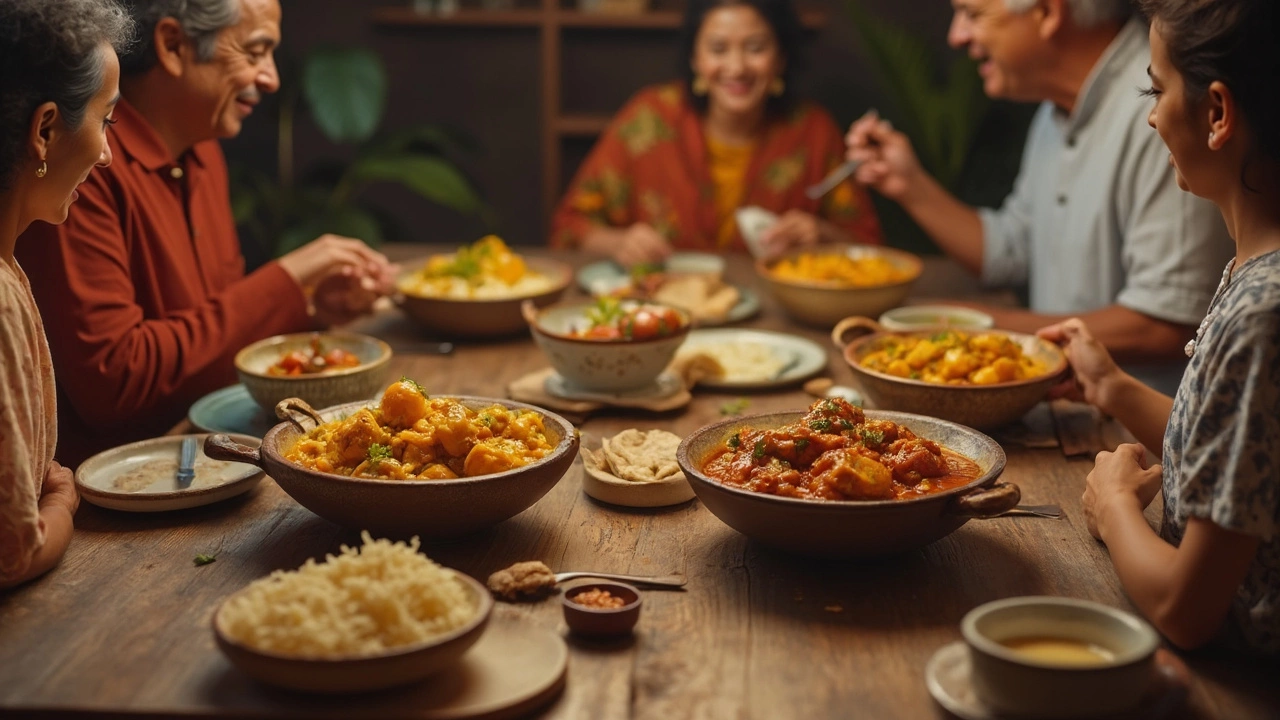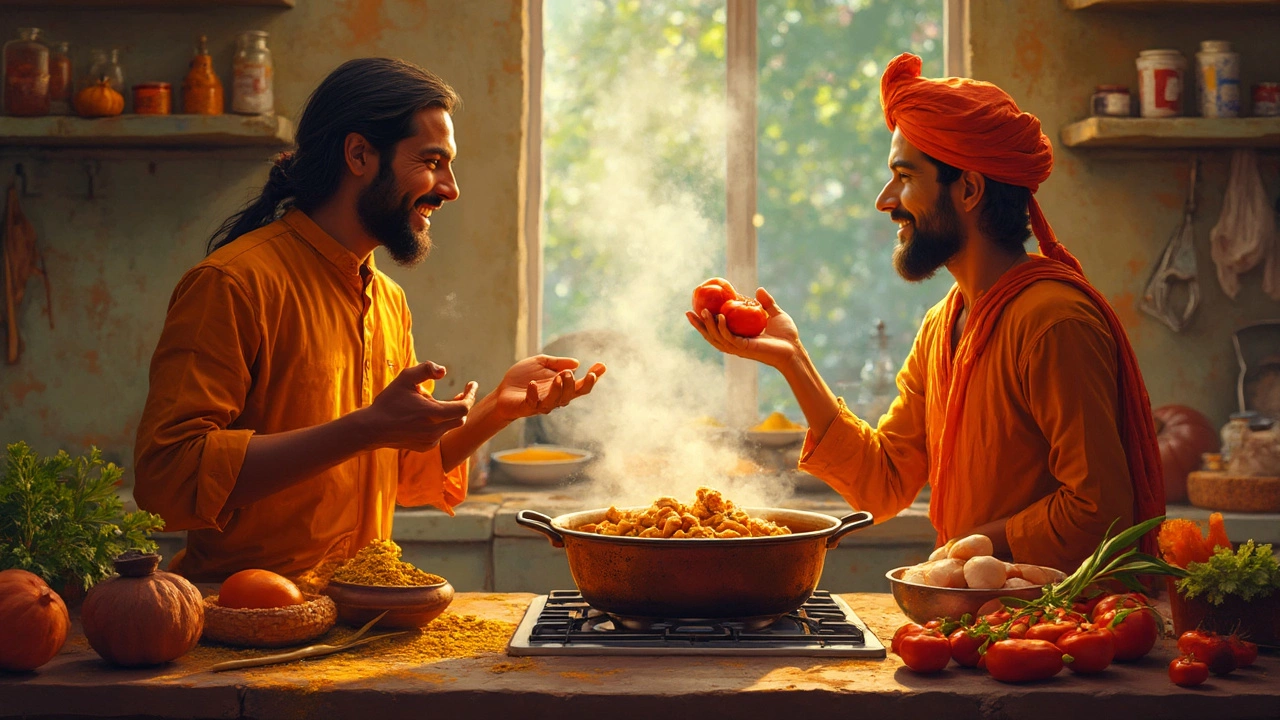Ever noticed how some chicken curries are deep red, rich, and tangy, while others are creamy and golden? Tomatoes have a lot to do with that. If you peek into kitchens across India, you'll see cooks arguing about tomatoes—should you pile them in or toss them out? This isn't just about taste. It's also about tradition and what you want out of your curry.
Tomatoes add more than just color. They bring out sharpness and cut through the heaviness of meat and spices. Basically, they help to balance flavors when your curry is feeling a bit one-note or oily. But, too much tomato and your curry can end up tasting more like pasta sauce than something you'd scoop with naan.
If you want your curry thick, tangy, and a little sweet, tomatoes are your friend—especially for North Indian-style recipes. But if you're craving a South Indian or Mughlai chicken curry, you might get better results by skipping tomatoes altogether or swapping them for yogurt, coconut milk, or even tamarind.
- Why Tomatoes Ended Up in Curries
- What Tomatoes Actually Do in Curry
- When to Skip (or Substitute) Tomatoes
- Pro Tips: Getting the Tomato Balance Right
Why Tomatoes Ended Up in Curries
Tomatoes feel like they've always been part of Indian cooking, but that's not how it started. They actually came from South America and only landed in Indian kitchens in the late 1700s, after Portuguese traders brought them to Goa. Before that, curries used sour ingredients like yogurt, tamarind, or dried mango to get that tangy kick.
What made tomatoes stick? For one, they're cheap and available year-round. Plus, their natural tang and sweetness perfectly balance hot spices and heavy flavors in curry. Once tomatoes caught on, home cooks and restaurants started putting them in all kinds of chicken curry recipes—especially in the North, where rich and spicy meals are the norm.
Here's a quick look at how key souring ingredients for curry changed over time:
| Ingredient | Region/Use | Era of Popularity |
|---|---|---|
| Yogurt | North India | Ancient to Present |
| Tamarind | South India | Ancient to Present |
| Dried Mango (Amchoor) | North India | Before tomatoes, still used |
| Tomatoes | All over India (esp. North & urban) | Since late 1700s |
Industrial canning and transport made it even easier to use tomatoes in curry. Tomato puree replaced hours of cooking fresh tomatoes down to a sauce. Indian restaurants around the world now rely on canned tomatoes for that reliable, bold color and tang in their signature chicken curries.
What Tomatoes Actually Do in Curry
So, what’s the actual job of tomatoes in your chicken curry? First up, they give a tangy kick—just enough acidity to liven up flavors, which helps keep the dish from feeling too heavy. Tomatoes also break down into a saucy base when you cook them long enough, thickening the gravy and helping all the spices soak in better.
But that’s not all. Tomatoes bring natural sugars, and those help mellow out the bitter edge of strong spices like garam masala and turmeric. This sweet-tangy duo means your curry doesn’t taste flat. Also, tomatoes contain glutamic acid (yep, the same stuff in MSG), so you get that yummy savory taste, what chefs call umami.
If you look at curries from different regions, the tomato pro-tip shows up again and again:
- North Indian curries (think butter chicken) use tomatoes for a smooth, reddish sauce.
- Some Bengali curries lean on cherry tomatoes for a sharper, fruitier punch.
- South Indian curries use them to brighten up thick coconut gravies.
The difference between fresh and canned tomatoes is worth talking about. Fresh tomatoes are less acidic and a bit sweeter but need longer to break down fully. Canned tomatoes are more tangy and strong, so you need to adjust salt or cook them down more. Here’s a quick look at what tomatoes bring to the table:
| Tomato Role | Effect in Curry |
|---|---|
| Acidity | Cuts through fat, balances creamy ingredients |
| Thickener | Adds body to the curry base |
| Natural Sugar | Rounds off harsh spices |
| Umami | Makes the curry taste deeper and richer |
| Color | Gives a nice reddish hue—restaurant vibes |
As chef Ranveer Brar puts it:
"The humble tomato is the backbone of dozens of our best-loved curries. It pulls the flavors together—without it, the curry just feels unfinished."
So when you’re eyeing those tomatoes before cooking, think about the end result you want. Sometimes, it’s the difference between a curry people remember and one they forget.

When to Skip (or Substitute) Tomatoes
If you think every chicken curry needs tomatoes, that's not really true. There are loads of classic recipes—like butter chicken, some South Indian curries, or even old-school Mughlai versions—where tomatoes are just not traditional. These dishes use things like yogurt, cream, or coconut milk instead, giving them a richer, silkier texture that you won’t get with tomatoes.
So, when should you skip tomatoes? Here are a few clear signs:
- You want your curry mild and creamy, not tangy.
- The recipe comes from a region that mostly uses dairy or coconut, like Kerala or Punjab.
- You're following traditional Mughlai recipes or classic dhaba-style curries where tomatoes were never part of the original.
- You need to avoid tomatoes for health reasons – maybe you're sensitive to acidity or tomatoes give you heartburn.
If you decide to swap out tomatoes, there are practical alternatives. Yogurt is perfect for adding smoothness and tang, but make sure it’s full-fat so your curry doesn’t split. Coconut milk makes the curry sweet, nutty, and rich, which is great for South Indian flavors. Tamarind pulp is another option—it brings in sourness, but it’s totally different from tomato tang.
Just to make life easier, check out this quick comparison of tomato substitutes:
| Substitute | Main Effect in Curry | Best Used In |
|---|---|---|
| Yogurt | Tangy, creamy | North Indian, Mughlai curry |
| Coconut Milk | Rich, sweet, smooth | South Indian, Thai-style curry |
| Tamarind Pulp | Sour, fruity | South Indian, Goan curry |
| Cashew Paste | Creamy, mild | Korma, festive gravies |
Don't just follow a recipe blindly because it calls for tomatoes. Think about what flavor you want at the end. If your curry dreams are more buttery than tangy, you’re absolutely allowed to skip that tomato can.
Pro Tips: Getting the Tomato Balance Right
Getting the tomato situation just right can be tricky, but a few smart moves can totally change your chicken curry game. Here’s what works, whether you’re making curry for two or feeding a whole group.
- Go easy at first. Start with one medium tomato per 500 grams of chicken. You can always add more if you want extra tang, but you can’t take it out once it’s in there.
- Type matters. Ripe, red tomatoes are best. If you use underripe ones, the curry can turn sour and even a bit bitter. Canned tomatoes are super convenient, but go for whole peeled ones instead of pre-made puree—the flavor is fresher and less metallic.
- Watch the water. Tomatoes throw out liquid when they cook. If you want a thicker curry, cook the tomatoes longer on high heat to evaporate excess moisture before adding chicken. For a thinner gravy, cover and simmer so the juices stay in.
- Spices fix mistakes. Went overboard on tomatoes? Add a tiny bit of sugar or a spoonful of cream to tone down the tang. Onions, too, can add sweetness and body if the curry tastes too tomato-heavy.
- Timing is everything. Fry your tomato pieces until the oil separates from the masala—this step removes the raw smell and brings out a deeper flavor. Skipping this leads to that sharp, sour taste most people try to avoid.
Still in doubt? Here’s a quick cheat sheet that shows how much tomato works for different curry styles:
| Curry Style | Fresh Tomato (per 500g chicken) | Notes |
|---|---|---|
| North Indian | 1-2 medium | Classic tang, pairs with spices |
| South Indian | 0-1 small | Often replaces with coconut/tamarind |
| Mughlai/Butter Chicken | 1-1.5 medium | Add cream to mellow tartness |
| British-style Curry | 2-3 medium | Chunky sauce, bright red color |
If you’re using tomato paste, dial it way back—a half tablespoon goes a long way. Remember, you want tomato to play backup, not steal the show. And if your tomatoes are too tart, a pinch of jaggery or regular sugar saves the pot. Keep tasting as you cook and adjust with something creamy or a bit of extra oil if that tang just won't quit.
